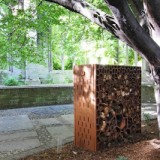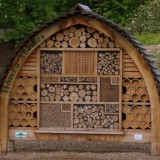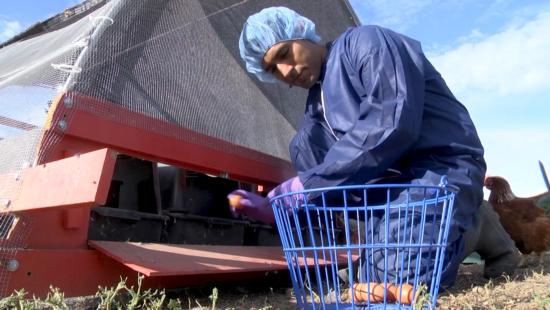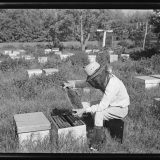We’re very lucky, here in Los Angeles, to have the Backwards Beekeepers whose meetings are led by beekeeper Kirk Anderson, who teaches a radical form of beekeeping that includes:
- Letting the bees form their own comb (most beekeepers use pre-made foundation).
- Capturing feral swarms, rather than ordering bees.
- Using no treatments of any kind.
The result is healthier bees with much more robust immune systems than their over-bred and drugged commercial sisters. But walk into most beekeeping clubs or supply shops, tell them you want to keep bees this way and they’ll think you’re crazy. And pretty much all beekeeping books have devolved into little more than timetables for applying chemical and biological treatments in the hopes of staving off all the problems that have plagued beekeeping in recent years. Even the organic beekeeping books are bad, substituting chemical treatments with gimmicks.
Finally, there’s a book that gets beekeepers off the treadmill of more and more drug treatments with ever diminishing returns. I heard that when the Idiots Guide publishers approached beekeepers Dean Stiglitz and Laurie Herboldsheimer they said they’d write the book but only if they could base it on no-treatment beekeeping. The result is the excellent Complete Idiot’s Guide to Beekeeping which contains everything you need to know to get started keeping bees. It’s the first book to describe no-treatment beekeeping and it also clearly explains the basic biology of the hive, no easy task. The book’s approach is summed up on page 139, “We keep a bunch of bees, don’t use treatments on them, and we don’t breed from the ones that die.” While not the only cause, standard commercial beekeeping practices probably play a big role in recent bee colony losses. Funny how the kind of common sense delivered in this book can seem so radical.
You can also read more about no-treatment beekeeping on the Yahoo Organic Beekeepers group and the website of Michael Bush.






Thanks for pointing out this book. I’ve already decided on a top bar hive because I found plans online and am confident that I have the carpentry skills required to put one together. This book would be the other side of what I need. Hopefully, they cover how to catch a wild hive? And how would you know it’s wild, as opposed to someone’s domestic, commercial hive that swarmed?
Agreed with the above comment – thank you for pointing this book out. There are a lot of books out there, but its always great to get comments and recommendations that aren’t just from those marketing the book.
Keep up the good work.
-JW
Radical as in awesome!
Paula,
The book does cover how to capture a swarm. It warns against beginners attempting it but I disagree somewhat with that. As long as you’re not climbing a tree or very high on a ladder, it’s pretty easy. Basically what you do is spray the swarm with a mixture of half water/half white sugar to keep them immobilized. Then you hold up a box as close as possible to the swarm and give them a gentle bump or brush them into the box and take them back to your hive. That’s it–really simple. Wear a veil and suit–while most swarms are gentle you can occasionally run across a grumpy one. The book also covers top bar hives. Good luck!
Thanks for the book suggestion! Have you looked into Warre Beekeeping? It’s consistent with your principles and even easier than Kenyan Top Bar hives. I’d love to know if your Backwards Beekeeper has tried it. You can download the book “Beekeeping For All” for FREE at http://thebeespace.net/warre-hive/ I’ve just started two Warre hives as a novice . . .so far so good.
Paula,
Forgot to say that there’s no way to know if a swarm came from some beekeeper’s bad stock. It’s a chance you take.
Mark,
I’m intrigued with Warre hives and like the fact that they go vertical rather than horizontal as with top bar hives. Let us know how it works for you.
For the standard beek world this is extremely radical, sort of like when Galileo said the world was round. Just because you believe the world is flat doesn’t make it so. Excellent!
I love tbh mainly because they are horizontal, if you go warre just make sure they are legal in your area, some places are more strict about movable comb then others.
Hi,
I just discovered your blog via a google search for solar dehydrator…..I dig it! We just put bees in four new top bar hives last week. This book looks good….thanks for sharing. I’ve read a few beekeeping books, but they seem so complex….and each book tells you something completely different which leaves me feeling so confused.
Keep up your good work.
Sara
Bees are but a “someday/maybe” thing for me, but it’s good to know there are resources like this out there – and that a more natural approach can work.
To digress, but hopefully not to be a pedantic ass, Sam, Galileo was considered radical because he supported Copernicus’ model that showed the earth orbiting the sun rather than the universe orbiting the earth.
A spherical earth stopped being a radical thought with the ancient Greeks.
A swarm is not from someones BAD stock! You need to know more about bees before making such a statement. Bees only swarm when the hive is healthy. Its bees way of increasing the species. A hive that is weak or unhealthy will not be able to swarm. The only caution is if you live in an area that may have africanized honeybees (check with local bee club). Also top bar hive are good but may not be suited for your area if you have below freezing temps. As the design is really called a Kenyan top bar hive and help disperse the heat in the hive. In cold weather a warre or Langstroth hive may be a better chioce.
Also Warre hives are not new or radical they have been around for a long time many beeks still use them. But there is very little difference between a Warre and keeping bees in a Langstroth foundationless its just a little harder to get parts for a Warre and buy nucs that will fit in them (same for TBH).
Laurie,
Thanks for your clarification. As for Africanized bees I need to do a post someday. David Theodoropoulos, speaking of plants, but this could apply to bees as well says (my thoughts inserted), “We find “invaders” [i.e. Africanized bees] to be disturbance indicators only, symptoms of industrial abuse of the land [such as industrial beekeeping practices], integrating ecologically, and with many beneficial effects that are carefully ignored by those promoting a ‘crisis'”
In the case of those promoting an Africanized bee crisis we have vector control agents, exterminators and pesticide manufacturers. There certainly are aggressive Africanized hives but there are also calm ones as well as “killer” European hives. One of the arguments for keeping feral bees, of course is greater genetic diversity.
And, in my own case, I’ve found buying unassembled, foundationless Langstroth boxes convenient and inexpensive.
Good luck catching the “calm” Africanized bees. I’ll stick to my “killer” European bees.
Anonymous,
I’ve assisted in relocating 10 feral hives here in Southern California–Africanized territory. We don’t have room in our yard for bees, but I would not hesitate to keep any of these colonies. None have been overly aggressive even those being cut out of walls. I also suspect, though admittedly I can’t prove, that they are healthier than commercially bred bees.
Yes Anonymous, each hive has its own temperament. The people giving speeches about africans have mostly never even attempted to cultivate them. I just took a wild hive home, and they could not be more gentle and calm.